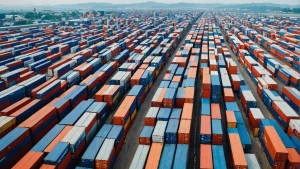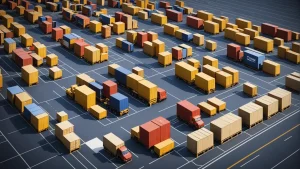Outbound logistics can make or break your business. Get it right, and you’ll see happier customers, lower costs, and more room to grow. But let’s be real: managing the flow of goods from your warehouse to your customer’s doorsteps is no walk in the park.
That’s where these 10 proven strategies come in. From streamlining order fulfillment to leveraging automation, we’ll show you how to take your outbound logistics from average to outstanding. No more lost shipments, no more angry customers, and no more headaches for you.
So buckle up and get ready to optimize your way to success. Your business (and your sanity) will thank you.
What is Outbound Logistics?
Outbound logistics involves storing, transporting, and distributing goods from a company to its customers.
Efficient outbound logistics is crucial for customer satisfaction and business success.
Optimizing outbound logistics can lead to cost savings, improved delivery times, and enhanced competitiveness.
Market Size & Growth:
Outbound Logistics Market size was valued at USD 2.7 trillion in 2023 and is estimated to register a CAGR of 7.2% between 2024 and 2032.
Examples of Outbound Logistics Processes
Outbound logistics encompasses a wide range of activities that ensure products reach their intended destinations. These activities include:
1. Warehousing and Storage: Storing finished goods until they are ready to be shipped to customers. This involves managing inventory levels, organizing products within the warehouse, and ensuring proper storage conditions to maintain product quality. Discover the efficiency of cross-docking techniques, which bypass traditional warehousing by moving products directly from receiving to outgoing trucks, speeding up the distribution process.
2. Order Processing and Fulfillment: Receiving and processing customer orders, picking and packing the products, and preparing them for shipment. Efficient order fulfillment is crucial for meeting customer expectations and minimizing lead times.
3. Packaging and Labeling: Ensuring products are properly packaged to protect them during transportation and labeled correctly to facilitate accurate delivery. Appropriate packaging helps prevent damage and reduces the likelihood of returns. For items sensitive to temperature variations, the logistics of cold chain management play a crucial role in maintaining product integrity during transport.
4. Transportation and Shipping: Arranging for the physical movement of goods from the warehouse to the customer’s location. This may involve coordinating with carriers, selecting the most cost-effective and reliable shipping methods, and tracking shipments to ensure timely delivery.
5. Reverse Logistics: Managing the process of handling returns, repairs, and product disposal. Reverse logistics is an important aspect of outbound logistics, as it helps maintain customer satisfaction and minimizes the environmental impact of product disposal.
Types of Outbound Logistics
Outbound logistics services can be categorized into two main types based on the nature of the customer relationship and the specific requirements of each type.
Direct-to-Consumer (D2C) Logistics
D2C logistics involves shipping products directly to end-users, typically through e-commerce distribution channels. In this model, companies manage the entire supply chain, from product manufacturing to final delivery to the consumer’s doorstep. D2C logistics requires:
Efficient order processing systems to handle a high volume of individual orders.
Fast and reliable shipping options to meet consumer expectations for quick delivery.
Flexible and scalable warehousing solutions to accommodate fluctuations in demand.
Effective reverse logistics processes to handle returns and exchanges.
Business-to-Business (B2B) Logistics
B2B logistics involves transporting goods from one business to another, often in larger quantities and with longer lead times compared to D2C logistics. In this model, companies often ship products to distributors, wholesalers, or retailers, who then sell the products to end-users. B2B logistics requires:
Robust transportation networks to handle larger shipments and longer distances.
Efficient inventory management to ensure adequate stock levels and minimize carrying costs.
Collaborative relationships with supply chain partners to streamline processes and reduce lead times.
Customized logistics solutions to meet the specific needs of each business customer.
By understanding the different types of outbound logistics and their unique requirements, businesses can develop targeted strategies to optimize their supply chain operations and improve overall performance. Explore how the principles of just-in-time manufacturing can significantly enhance your outbound logistics, optimizing your supply chain for superior efficiency and performance.
Outbound Logistics Market Share:
FedEx, UPS, and DHL dominate outbound logistics industry holding market share over 7%.

With Metrobi, you can save 23% on delivery costs.
Metrobi provides you with a competitive driver pool, a dedicated operations manager, and included delivery management software. We decrease your overall costs by 23%.
Benefits of Optimizing Outbound Logistics
Optimizing outbound logistics brings numerous benefits to businesses, ultimately leading to improved customer satisfaction, reduced costs, and increased efficiency. By streamlining processes and leveraging technology, companies can ensure faster and more reliable delivery, accurate order fulfillment, and seamless returns and exchanges. Discover how to enhance your delivery strategies through advanced scheduling techniques by understanding the differences between scheduling in advance and backward scheduling, and determine which is ideal for your business operations.
Improved Customer Satisfaction
In today’s competitive market, customer satisfaction is a key differentiator for businesses. Optimizing outbound logistics plays a crucial role in meeting and exceeding customer expectations. By ensuring faster and more reliable delivery, companies can build trust and loyalty with their customers. Discover how managing backorders effectively can help maintain customer satisfaction and loyalty even when supply chain disruptions occur.
An important facet of logistics performance is monitoring and improving your Carrier Safety Assessment (CSA) scores. These scores can directly impact your logistics operations, from carrier selection to compliance with regulations. By focusing on strategies to enhance your CSA scores, you can improve safety and operational efficiency, ultimately benefiting your overall logistics performance. Learn more about methods to improve your CSA scores and stay compliant with transportation industry regulations.
Faster and More Reliable Delivery
Streamlining outbound logistics processes enables businesses to reduce lead times and improve delivery speed. This can be achieved through optimized transportation routes, efficient warehousing and other distribution centers, and strategic partnerships with reliable carriers. By leveraging technology such as real-time tracking and predictive analytics, companies can proactively address potential delays and ensure timely delivery to customers. According to a study by McKinsey, 61% of customers expect same-day or next-day delivery, and 75% are more likely to return to a retailer that offers fast and reliable shipping.
Accurate Order Fulfillment
Accurate order fulfillment is essential for maintaining customer satisfaction. Optimizing outbound logistics involves implementing robust inventory management systems, automating pick and pack processes, and utilizing barcode scanning and RFID technology to minimize errors. By ensuring the right products are delivered to the right customers in the right quantities, businesses can reduce returns and exchanges, saving time and costs while enhancing customer trust.
Seamless Returns and Exchanges
Despite best efforts, returns and exchanges are inevitable inbound logistics processes for any business. Optimizing outbound logistics includes streamlining the returns process to make it as seamless and hassle-free as possible for customers. This involves providing clear return policies, offering multiple return options (such as in-store, mail, or courier pickup), and processing refunds or exchanges promptly. By making returns and exchanges easy for customers, businesses can maintain customer loyalty and encourage repeat purchases.
Reduced Costs and Increased Efficiency
Optimizing outbound logistics not only benefits customers but also helps businesses reduce costs and increase efficiency in their supply chain operations. By streamlining processes, minimizing errors, and optimizing resource utilization, companies can achieve significant cost savings and improve their bottom line.
Streamlined Processes and Fewer Errors
Implementing standardized processes and utilizing automation technology can greatly reduce errors and inefficiencies in outbound logistics. For example, using barcode scanning and RFID technology ensures accurate inventory tracking and reduces manual data entry errors. Automated pick and pack systems minimize human error and improve order accuracy. By streamlining processes and reducing errors, businesses can save time and resources while improving overall efficiency.
Lower Transportation and Storage Costs
Optimizing transportation routes, consolidating shipments, and leveraging strategic partnerships with carriers can significantly reduce transportation costs. By analyzing data on shipping patterns, businesses can identify opportunities for cost savings, such as utilizing off-peak delivery times or negotiating better rates with carriers. Additionally, optimizing WMS and utilizing space efficiently can reduce storage costs and improve inventory turnover. For instance, a study by the National Shippers Strategic Transportation Council found that optimizing transportation routes can reduce costs by up to 15%.
Optimized Inventory Management
Effective inventory management is crucial for reducing costs and increasing efficiency in inbound logistics outbound logistics. By utilizing demand forecasting and inventory optimization techniques, businesses can maintain optimal stock levels, reducing the risk of stockouts or overstocking. This helps minimize inventory carrying costs, such as storage, obsolescence, and tied-up capital. Advanced inventory management systems provide real-time visibility into stock levels, enabling proactive replenishment and reducing the need for expedited shipments.
Enhanced Supply Chain Visibility: Inbound and Outbound Logistics
Optimizing outbound logistics also enhances supply chain visibility, enabling businesses to make better decisions, solve problems more effectively, and improve collaboration with partners. Real-time tracking and monitoring, coupled with data analytics, provide valuable insights into the entire outbound logistics process.
Real-Time Tracking and Monitoring
Implementing real-time tracking and monitoring systems allows businesses to have complete visibility into the movement of goods from the warehouse to the customer’s doorstep. This includes tracking shipments, monitoring delivery status, and receiving alerts for any deviations or delays. Real-time visibility enables proactive problem-solving and communication with customers, enhancing their experience and trust in the brand.
Better Decision-Making and Problem-Solving
Enhanced supply chain visibility provides businesses with data-driven insights for better decision-making and problem-solving. By analyzing data on shipping patterns, delivery performance, and customer feedback, companies can identify areas for improvement and make informed decisions to optimize their outbound logistics. For example, data analysis may reveal bottlenecks in the shipping process, allowing businesses to take corrective actions and improve efficiency.
Improved Collaboration with Partners
Optimizing outbound logistics also facilitates better collaboration with supply chain partners, such as carriers, 3PLs, and customers. Real-time data sharing and seamless communication channels enable all stakeholders to work together more effectively. For instance, sharing real-time tracking information with carriers helps them optimize their routes and improve delivery performance. Collaborating with customers on delivery preferences and providing them with self-service tracking options enhances their experience and reduces the burden on customer support teams.
How Outbound Logistics Benefits Businesses
Competitive Advantage
In today’s fast-paced business environment, the ability to deliver products quickly and reliably is a key differentiator. Companies with streamlined outbound logistics processes can get their products to customers faster than their competitors. This speed advantage can be the deciding factor for customers choosing between similar products or services. Experience the advantages of timely delivery! Learn how adopting a just-in-time strategy can enhance your competitiveness by making your supply chain more efficient and responsive.
Moreover, consistent and timely delivery builds trust and loyalty with customers. When a business repeatedly meets or exceeds customer expectations for delivery, it creates a positive reputation that can lead to repeat business and referrals. In contrast, companies with poor outbound logistics performance risk losing customers to competitors who can better meet their needs.
Case Study: Amazon’s Competitive Edge
Amazon’s success in e-commerce is largely due to its exceptional outbound logistics capabilities. The company’s vast network of fulfillment centers and its investment in cutting-edge technologies like robotics and machine learning have enabled it to offer fast, reliable delivery to customers around the world. This competitive advantage has helped Amazon capture a significant share of the online retail market. According to a report by Statista, Amazon accounted for approximately 44.1% of the U.S. e-commerce market share in 2022.
Increased Profitability
Efficient outbound logistics can have a direct impact on a company’s bottom line. By optimizing processes like inventory management, transportation, and returns handling, businesses can reduce costs associated with these activities. This frees up capital that can be invested in other areas of the business, such as product development or marketing. Explore how sustainable transportation methods can further boost your company’s financial health by reducing expenses and enhancing your brand image.
For example, implementing a lean inventory management system can help minimize the costs of holding excess stock, which ties up capital and incurs storage fees. Similarly, partnering with reliable, cost-effective transportation providers can reduce shipping expenses without sacrificing delivery speed or quality.
The Cost of Poor Outbound Logistics
Inefficient outbound logistics processes can lead to significant financial losses for businesses. A study by the Global Supply Chain Institute found that companies with poor supply chain performance had an average of 10-20% higher costs than their peers with best-in-class supply chains (Fawcett et al., 2015). More recent data from a 2020 study by McKinsey & Company suggests that companies with optimized supply chains can reduce costs by up to 15%.
Scalability and Growth
A well-designed outbound logistics system can help businesses scale and grow by accommodating increased order volumes and enabling expansion into new markets or sales channels. As a company’s customer base and product offerings grow, its outbound logistics processes must be able to keep pace without sacrificing efficiency or customer service.
Investing in scalable logistics infrastructure, such as larger warehouses or automated sorting systems, can help businesses handle higher order volumes without incurring exponential cost increases. Additionally, partnering with logistics providers that have a global presence can make it easier for companies to expand into new geographic markets.
Large Enterprises Dominate Outbound Logistics:
The large enterprises segment accounted for around 66% of the outbound logistics market share in 2023.
The Role of Technology in Scalable Outbound Logistics
Advanced technologies like warehouse management systems (WMS), transportation management systems (TMS), and robotics are playing an increasingly important role in enabling scalable, efficient outbound logistics. These tools can automate and optimize various aspects of the order fulfillment process, from inventory tracking to route planning, helping businesses handle higher volumes with less manual effort. For instance, a study by the International Journal of Production Research found that the use of WMS can improve warehouse efficiency by up to 25%.
Improved Customer Satisfaction
Ultimately, the benefits of efficient outbound logistics all contribute to one crucial outcome: improved customer satisfaction. When products are delivered quickly, accurately, and in good condition, customers are more likely to have a positive experience with the brand. This can lead to increased loyalty, repeat purchases, and positive word-of-mouth referrals.
In addition to speed and accuracy, outbound logistics can also impact customer satisfaction through factors like packaging and returns processing. Providing eco-friendly, protective packaging shows customers that a brand cares about both product quality and environmental sustainability. Similarly, offering hassle-free returns with prepaid shipping labels and quick refund processing can turn a potentially negative experience into a positive one.
The Importance of Last-Mile Delivery
The last mile of delivery, which involves getting a product from a transportation hub to the end customer’s doorstep, is critical to customer satisfaction. Investing in technology and partnerships to improve last-mile delivery performance can have a major impact on customer satisfaction. Strategies like real-time tracking, flexible delivery options, and localized storage can help ensure timely, accurate delivery. According to a study by the National Retail Federation, 73% of consumers consider fast and reliable shipping to be a key factor in their online shopping decisions.
Over Half of Logistics Market Driven by Road Transport:
In 2023, road transportation segment accounted for a market share of over 49% and is expected to exceed USD 2.37 trillion by 2032.
Enhanced Brand Reputation
Building on customer satisfaction, efficient outbound logistics can also contribute to a stronger overall brand reputation. When a company consistently delivers on its promises to customers, it builds trust and credibility in the market. This positive reputation can help attract new customers and differentiate the brand from competitors.
Moreover, demonstrating competence in the challenges of outbound logistics can help a brand establish itself as a reliable partner for other businesses. For example, a manufacturer with a reputation for timely, accurate delivery may be more likely to win contracts with retailers or distributors. A strong reputation in outbound logistics can thus open up new growth opportunities for a business.
The Power of Positive Reviews
In the digital age, online reviews and ratings have become a crucial factor in shaping brand reputation. Positive reviews from satisfied customers can attract new business, while negative reviews can deter potential customers. Ensuring excellent outbound logistics processes inbound performance can help businesses earn more positive reviews related to factors like delivery speed, product condition, and returns processing. According to a study by BrightLocal, 85% of consumers trust online reviews as much as personal recommendations.
Outbound Logistics Strategies for Optimization
Outbound logistics plays a crucial role in ensuring that products reach customers efficiently and cost-effectively. To optimize your outbound logistics activities, consider implementing these proven strategies:
Implement Inventory Management Systems
Accurate inventory tracking is essential for successful outbound logistics. By implementing an inventory management system, you can:
Accurately Track Stock Levels and Locations
An effective inventory management system provides real-time visibility into stock levels and locations. This allows you to quickly identify shortages, overstocks, and potential bottlenecks in your supply chain.
According to Mike Glodziak, President and CEO of LEGACY Supply Chain Services, “Inventory accuracy is the foundation of effective supply chain management. Without it, you’re flying blind and making decisions based on guesswork rather than data.”
Automate Reordering and Replenishment
Automated reordering and replenishment systems ensure that you always have the right products in stock when you need them. By setting reorder points based on historical sales data and lead times, you can minimize stockouts and overstocks.
As stated by James Cooke, Editor of DC Velocity, “Automated replenishment systems can help reduce inventory levels by as much as 30% while improving service levels and reducing stockouts.”
Streamline Order Fulfillment Processes
Efficient order fulfillment is critical for meeting customer expectations and reducing costs. To streamline your order fulfillment processes:
Integrate Order Management and Warehouse Management Systems
Integrating your order and warehouse management system and warehouse management systems allows for seamless communication and data exchange. This reduces errors, improves accuracy, and speeds up order processing.
Steve Banker, Vice President of Supply Chain Services at ARC Advisory Group, notes that “Integrating order management and warehouse management systems can reduce order processing times by up to 50% and improve order accuracy by as much as 99%.”
Use Barcode Scanning and Pick-to-Light Technology
Barcode scanning and pick-to-light technology can significantly reduce picking errors and improve efficiency. By providing workers with clear visual cues and reducing manual data entry, these technologies streamline the order fulfillment process.
According to Dwight Klappich, Research Vice President at Gartner, “Implementing barcode scanning and pick-to-light technology can improve picking accuracy by up to 99.9% and increase productivity by as much as 25%.”
Optimize Packaging and Labeling
Proper packaging and labeling are essential for protecting products during shipping and ensuring accurate delivery. To optimize your packaging and labeling:
Use Durable, Cost-Effective Materials
Selecting the right packaging materials can help reduce shipping costs while protecting your products from damage. Consider factors such as product fragility, weight, and dimensions when choosing packaging materials.
Jack Ampuja, President of Supply Chain Optimizers, advises that “By using the right packaging materials, companies can reduce shipping costs by up to 20% while improving product protection and customer satisfaction.”
Ensure Clear and Accurate Labeling for Shipping and Tracking
Clear and accurate labeling is critical for ensuring that products are delivered to the correct destination and can be easily tracked throughout the shipping process. Use standardized labeling formats and include all necessary information, such as product descriptions, quantities, and tracking numbers.
David Krebs, Executive Vice President at VDC Research, emphasizes that “Accurate labeling is essential for ensuring smooth shipping operations and maintaining customer trust. Mislabeled or poorly labeled packages can lead to delivery delays, lost products, and dissatisfied customers.”
Leverage Transportation Management Systems
Transportation management systems (TMS) can help optimize your outbound and inbound logistics by:
Comparing Rates and Routes from Multiple Carriers
A TMS allows you to compare rates and routes from multiple carriers, enabling you to select the most cost-effective and efficient shipping options for each order.
According to Adrian Gonzalez, President of Adelante SCM, “A transportation management system can help companies reduce freight costs by 5-10% through carrier selection, load optimization, and route planning.”
Consolidating Shipments and Optimizing Load Planning
By consolidating shipments and optimizing load planning, you can reduce transportation costs and improve efficiency. A TMS can help you identify opportunities for consolidation and create optimal load plans based on factors such as weight, dimensions, and delivery requirements.
Chris Jones, Executive Vice President of Industry and Services at Descartes Systems Group, states that “Shipment consolidation and load optimization can reduce transportation costs by up to 20% while improving on-time delivery performance and reducing carbon emissions.”
Embrace Automation and Robotics
Automation and robotics can revolutionize your outbound logistics by:
Automating Repetitive Tasks Like Picking and Packing
Automating repetitive tasks, such as picking and packing, can significantly improve efficiency and accuracy. Automated systems can work around the clock, reducing labor costs and minimizing human error.
John Santagate, Research Director for Commercial Service Robotics at IDC, notes that “Automated picking systems can improve picking accuracy by up to 99.99% and increase throughput by as much as 300% compared to manual picking processes.”
Utilizing Robotic Systems for Faster, Error-Free Operations
Robotic systems, such as autonomous mobile robots (AMRs) and automated guided vehicles (AGVs), can streamline material handling and transportation operations within your warehouse. These systems can navigate autonomously, and safely working alongside human workers to improve efficiency and reduce errors.
According to John Paxton, CEO of MHI, “Robotics and automation are transforming the supply and value chain, enabling companies to achieve new levels of efficiency, accuracy, and flexibility. The use of robotics in warehousing and logistics is expected to grow by over 30% annually through 2025.”
By implementing these outbound logistics strategies, your business can optimize its supply chain, reduce costs, and improve customer satisfaction. Embracing technology and best practices will be essential for staying competitive in today’s rapidly evolving outbound logistics focuses and landscape.
How Technology Helps Outbound Logistics
Real-Time Visibility and Tracking
Real-time tracking is a game-changer for outbound logistics. By using GPS tracking devices on shipments and vehicles, businesses can monitor the location and status of their goods at all times. This allows for quick identification of delays or issues, enabling proactive problem-solving and improved customer communication.
Sensors for Monitoring Conditions
In addition to location tracking, sensors can be used to monitor conditions such as temperature, humidity, and shock. This is particularly important for sensitive or perishable goods, ensuring they remain within acceptable ranges during transport. If any issues are detected, alerts can be triggered for immediate action.
Real-time visibility also helps with route optimization, allowing dispatchers to adjust routes based on traffic, weather, or other factors. This can lead to more efficient deliveries, reduced fuel costs, and improved customer satisfaction.
Data Analytics and Optimization
Data is a powerful tool for optimizing outbound logistics. By collecting and analyzing data from various sources, such as tracking devices, sensors, and customer feedback, businesses can identify trends, bottlenecks, and opportunities for improvement.
Identifying Trends and Bottlenecks
For example, data analytics can reveal patterns in delivery times, highlighting routes or processes that consistently cause delays. This information can be used to adjust schedules, reallocate resources, or investigate the root causes of issues.
Data can also be used to predict demand and optimize inventory levels. By analyzing historical sales data, seasonal trends, and other factors, businesses can forecast future customer demand more accurately. This helps avoid stockouts or overstocking, reducing costs and improving customer satisfaction.
According to McKinsey, data analytics can revolutionize supply chains by improving efficiency and reducing costs. For instance, a study by McKinsey found that data analytics can reduce inventory costs by up to 20% and improve delivery times by up to 10%.
Cloud-Based Collaboration Platforms
Cloud-based platforms are transforming how businesses collaborate with partners in outbound logistics. By providing a centralized hub for sharing data, documents, and communications, these platforms streamline operations and reduce errors.
Sharing Data and Documents with Partners
For example, instead of relying on email or phone calls to share shipping manifests or customs documents, businesses can upload them to a secure cloud platform. Partners can then access the latest versions at any time, from anywhere. This eliminates version control issues and ensures everyone is working with the most up-to-date information.
Cloud platforms also enable real-time collaboration, such as coordinating pickup and delivery schedules across multiple locations. Changes can be made and communicated instantly, reducing delays and miscommunications.
Some popular cloud-based collaboration platforms for logistics include SAP Logistics Business Network, Oracle Cloud Logistics, and BluJay Solutions.
Automated Warehouse Management Systems
Warehouse management is a critical component of outbound logistics, and technology is revolutionizing how it’s done. Automated systems, such as robotic pickers and sorters, can significantly increase efficiency and accuracy in order fulfillment.
Robotic Pickers and Sorters
Robotic pickers use advanced vision systems and machine learning to identify and grab items from shelves, and then place them in bins for packing and shipping. This can be much faster and more accurate than manual picking, especially for high-volume operations.
Similarly, robotic sorters can automatically sort packages by size, weight, or destination, directing them to the appropriate loading bays or vehicles. This reduces errors and speeds up the loading process.
Automated systems can also integrate with inventory management software, updating stock levels in real-time as items are picked and shipped. This helps prevent overselling and ensures accurate inventory counts.
According to McKinsey, automation and robotics can significantly improve warehouse efficiency. For example, a study by McKinsey found that automation can increase warehouse productivity by up to 30% and reduce labor costs by up to 20%.
Blockchain for Supply Chain Transparency
Blockchain technology is emerging as a powerful tool for increasing transparency and trust in inbound and outbound logistics. By creating an immutable, decentralized ledger of transactions, blockchain can provide end-to-end visibility into the supply chain.
Tracking Goods from Origin to Destination
With blockchain, each step in the journey of a product can be recorded and verified, from raw materials to final delivery. This includes information such as origin, quality certifications, shipping details, and ownership transfers.
This level of transparency can help combat counterfeiting, fraud, and other supply chain risks. It also enables businesses to quickly trace the source of any issues, such as contaminated or defective products.
Blockchain can also streamline processes such as customs clearance and payments, by providing a trusted, shared source of documentation. This can reduce paperwork, delays, and disputes between parties.
For further reading on blockchain in logistics, check out these books:
“Blockchain and the Supply Chain: Concepts, Strategies, and Practical Applications” by Nada R. Sanders
“Blockchain for Transportation & Logistics” by Samantha Radocchia.
Measuring and Improving Outbound Logistics Performance
Key Performance Indicators (KPIs)
Measuring the right KPIs is crucial for monitoring and improving outbound logistics performance. Some essential KPIs to track include:
On-time delivery rate: This measures the percentage of orders delivered within the promised timeframe. A high on-time delivery rate indicates efficient logistics processes and helps maintain customer satisfaction. According to the United States Bureau of Transportation Statistics, the on-time delivery rate for ground transportation in the United States was approximately 95% in 2020.
Order accuracy rate: This KPI tracks the percentage of orders fulfilled correctly, including the right products, quantities, and packaging. Accurate order fulfillment reduces returns, refunds, and customer complaints. A study by the National Retail Federation found that the average order accuracy rate for e-commerce companies was around 92% in 2022.
Calculating Order Accuracy Rate
To calculate the order accuracy rate, divide the number of accurately fulfilled orders by the total number of orders processed within a specific period. For example, if a company processes 1,000 orders in a month and 950 of them are fulfilled accurately, the order accuracy rate would be:
Order Accuracy Rate = (950 / 1,000) x 100 = 95%
Inventory turnover ratio: This ratio measures how efficiently a company manages its inventory by calculating how many times inventory is sold and replaced within a given period. A higher inventory turnover ratio indicates better inventory management and reduced carrying costs. The average inventory turnover ratio for the retail industry was approximately 4.5 in 2020, according to the National Retail Federation.
Transportation cost per unit: This KPI measures the average cost of transporting each unit of product. Monitoring transportation costs helps identify opportunities for cost savings and optimization. The average transportation cost per unit for the logistics industry was around $1.50 in 2022, as reported by the Council of Supply Chain Management Professionals.
Continuous Improvement Initiatives
Implementing continuous improvement initiatives is essential for optimizing outbound logistics performance. Some effective strategies include:
Regularly review inbound logistics processes and identify areas for optimization: Conduct periodic audits of outbound logistics processes to identify bottlenecks, inefficiencies, and potential improvements. Engage employees at all levels to gather insights and ideas for optimization.
Implement lean principles and Six Sigma methodologies: Lean principles focus on eliminating waste and enhancing value for customers, while Six Sigma methodologies aim to reduce defects and variability in processes. Applying these approaches to outbound logistics can help streamline operations, reduce costs, and improve quality. For example, a study by the American Production and Inventory Control Society found that companies that implemented lean principles saw an average reduction of 30% in inventory costs and 25% in lead times.
Examples of Lean Principles in Outbound Logistics
Some examples of how lean principles can be applied to improve outbound logistics include:
Optimizing distribution center warehouse layouts to minimize travel time and distance for order picking and packing
Implementing just-in-time (JIT) inventory management to reduce storage costs and improve responsiveness
Standardizing packaging processes to reduce variability and improve efficiency
Benchmarking and Best Practices
Benchmarking performance against industry standards and learning from successful companies can help identify areas for improvement and adopt best practices. Consider the following:
Compare performance against industry standards: Research industry benchmarks for key outbound logistics metrics, such as on-time delivery rates, order accuracy rates, and inventory turnover ratios. Compare your company’s performance against these benchmarks to identify gaps and set improvement targets.
Learn from successful companies and adapt their strategies: Study the outbound logistics practices of industry leaders and successful competitors. Analyze their processes, technologies, and strategies to identify best practices that can be adapted to your organization. For example, a case study by the Harvard Business Review highlighted how companies like Amazon and Walmart have successfully implemented lean principles and Six Sigma methodologies in their outbound logistics refers and operations.
Resources for Benchmarking and Best Practices
Some resources for benchmarking and identifying best practices in outbound logistics include:
Industry associations and trade publications, such as the Council of Supply Chain Management Professionals (CSCMP) and Supply Chain Management Review
Case studies and whitepapers from logistics service providers and technology vendors
Conferences and networking events focused on supply chain and logistics optimization
By measuring key performance indicators, implementing continuous improvement initiatives, and benchmarking against industry standards, companies can effectively optimize their outbound logistics performance. This leads to reduced costs, improved customer satisfaction, and a competitive advantage in the market. Enhance your company’s logistics efficiency! Discover easy methods to assess carrying capacity, ensuring your shipments are optimized for cost-saving and superior service delivery.
Optimizing Outbound Logistics: Your Path to Success
Effective outbound logistics management is crucial for businesses looking to improve customer satisfaction, reduce costs, and gain a competitive edge. By implementing strategies such as inventory management systems, streamlined order fulfillment processes, and leveraging technology, you can optimize your outbound logistics operations and drive business growth. Discover how understanding demand forecast can further enhance outbound logistics by predicting customer needs and aligning inventory accordingly.
The key to success lies in continuously measuring and improving your performance using KPIs, benchmarking, and best practices. By staying proactive and adaptable, you can ensure that your outbound logistics remain a strong pillar of your business.
Are you ready to take your outbound logistics to the next level? Start by assessing your current processes and identifying areas for improvement. Then, develop a plan to implement the strategies and technologies that will help you achieve your goals.
Remember, optimizing outbound logistics is an ongoing journey, but the rewards are well worth the effort. With the right approach, you can deliver exceptional customer experiences, drive cost savings, and position your business for long-term success.



























